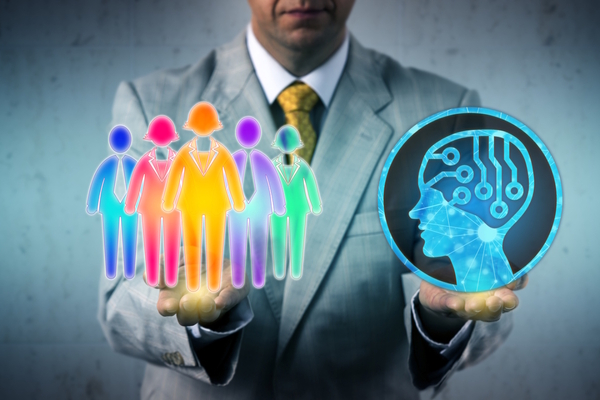AI with a human touch

Cathal McCarthy at Kore.ai argues that the companies getting AI right are those combining tech with the human touch
As AI continues to evolve, one thing is becoming abundantly clear: smart businesses aren’t replacing people with AI – they’re marrying the two to set a new standard for customer experience.
From instant support to automated self-service, AI has brought speed and scale to customer interactions that once relied entirely on people.
According to the Info-Tech Research Group, AI is spearheading the “fourth evolution of customer service, dramatically reducing wait times, personalising customer experiences and giving agents the tools they need to perform their jobs better.”
Over the last couple of decades, customer service has morphed from something bespoke and often in person – but impossible to scale – to one reliant on call centres where customers have to sit in a queue waiting to be spoken to. Automated phone systems may have helped to address the waiting times, but many can lack the custom, personal touch of such large-scale interactions.
Now, AI can revolutionise customer service by improving the experience for both customers and those who serve them. And the key is not to use technology instead of people, but to use AI alongside call agents.
Getting this balance right is the key to delivering the kind of customer experience people want – something that is fast and frictionless when it needs to be, but warm, nuanced and empathetic when it counts.
AI will serve you now
In retail, for example, AI agents are increasingly used to support everything from checking stock availability to managing returns. Its ability to analyse vast amounts of customer data – everything from purchasing history to browsing behaviour – allows retailers to offer unparalleled hyper-personalised shopping experiences.
One of our large global retail customers has built complex use cases, including a 24/7 Whatsapp and website AI agent so customers aren’t confined to usual 9am - 5pm office hours for any product availability or item return questions that can be answered quickly and efficiently. Customer order monitoring and tracking is also now possible at speed, to deliver superior, personalised and seamless experiences to consumers.
Furthermore, the agents are used to train teams on new product information as they can access pre-loaded information and create tailored product catalogues for different retail department teams.
But implementing this kind of collaboration doesn’t just mean switching on a bot and stepping back. Success hinges on how AI is introduced, adopted and integrated into existing workflows – and that applies to both customers and employees.
Take RCBC Credit in the Philippines, where the bank launched its AI agent – ‘Erica’ – in response to rising volumes of customer queries. Rather than getting Erica to deal with all customer enquiries, RCBC focused on solving just four key pain points: balance checks, promotions, card applications and card activations.
This managed approach allowed both staff and customers to get used to the new technology. And whenever Erica reaches the limit of what she can do, she passes the customer seamlessly to a human call agent to ensure business continuity without friction.
Fast forward to today, and Erica now manages over 600,000 customer interactions a year. On the back of this, responsibilities have been expanded to include rewards, redemptions and other functions. As a result, she’s expected to save the bank around 22 million pesos (roughly $400,000) a year in contact centre costs.
Better for customers and employees
What stands out in this example isn’t the money saved. Or the improved service. Or the fact that Erica’s freed up agents to spend more time handling customer enquiries. Instead, the technology solution has succeeded because it’s founded on a people-first strategy.
And that’s important. Because as every day passes, AI is becoming more sophisticated – and more ‘human’ – thanks to developments in generative AI, contextual awareness and agentic reasoning.
These technologies allow AI agents to understand customer intent more accurately, generate tailored responses and even anticipate needs. More than just reactive tools, these agents are able to resolve issues proactively or hand them over to a human at just the right moment.
In tourism and hospitality, for example, AI-powered concierges are changing how hotels interact with guests.
For instance, at the Clarion Hotel in Stockholm, an in-room AI ’butler’ helps guests order room service, hail a cab or request housekeeping with simple voice commands. In Las Vegas, the Cosmopolitan’s AI concierge, ‘Rose’, tells guests about the entertainment on offer and other hotel services.
While in Japan, the Henn na Hotel uses robot ‘porters’ to carry luggage to rooms. Admittedly, this last example may well be on the very edge of innovation. But all three point to a future where AI doesn’t just automate tasks – it enhances the sense of care, responsiveness and personalisation that defines great hospitality.
Adopting AI requires a cultural shift
And this isn’t only about customer-facing tasks. Some organisations are using AI internally to make their teams more effective. Tools that automatically summarise conversations, flag next steps, or pre-fill case notes are helping agents spend less time on admin and more time connecting with customers.
In this way, AI isn’t just improving the customer journey – it’s improving the employee experience too.
One major European bank has been steadily reimagining the employee experience with AI – from onboarding to day-to-day work for thousands of employees in multiple languages. For new hires, virtual assistants guide them through systems and answer common questions – no more waiting in help desk queues (including questions on more complex HR requests) While day-to-day, AI has been helping behind the scenes to speed up document processing and supports research and advisory teams in producing clearer, more consistent content.
And the impact goes beyond just tools and automation. That matters, because AI adoption isn’t just a tech decision – it’s a cultural one. The best deployments involve training, change management and clear communication about what AI will do – and what it won’t. What we’re seeing is that the most forward-thinking organisations are designing customer experience systems that let people and technology play to their strengths.
AI brings speed, scale and consistency. People bring judgement, creativity and care. It’s not about replacing one with the other – it’s about marrying the two to build something even better together.
Cathal McCarthy is Chief Strategy Officer at Kore.ai
Main image courtesy of iStockPhoto.com and Thinkhubstudio

Business Reporter Team
Most Viewed
Winston House, 3rd Floor, Units 306-309, 2-4 Dollis Park, London, N3 1HF
23-29 Hendon Lane, London, N3 1RT
020 8349 4363
© 2025, Lyonsdown Limited. Business Reporter® is a registered trademark of Lyonsdown Ltd. VAT registration number: 830519543





